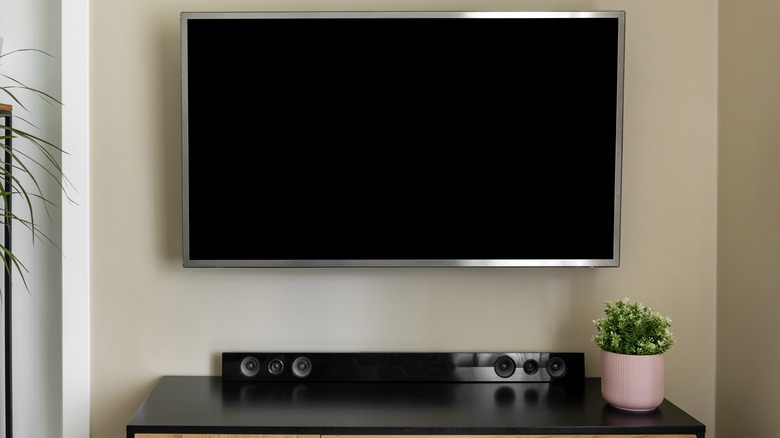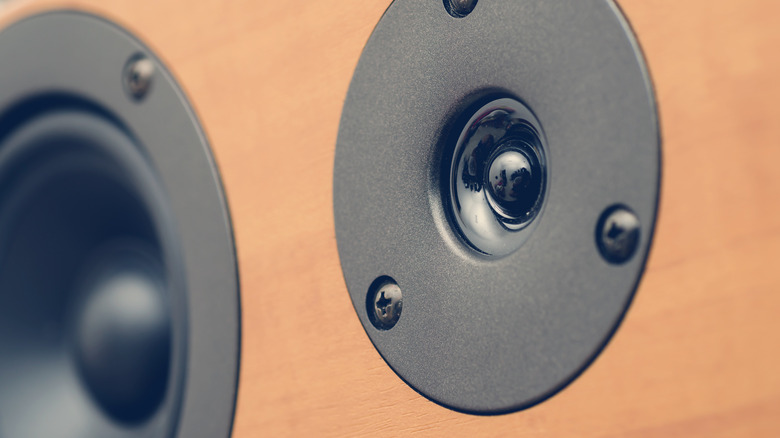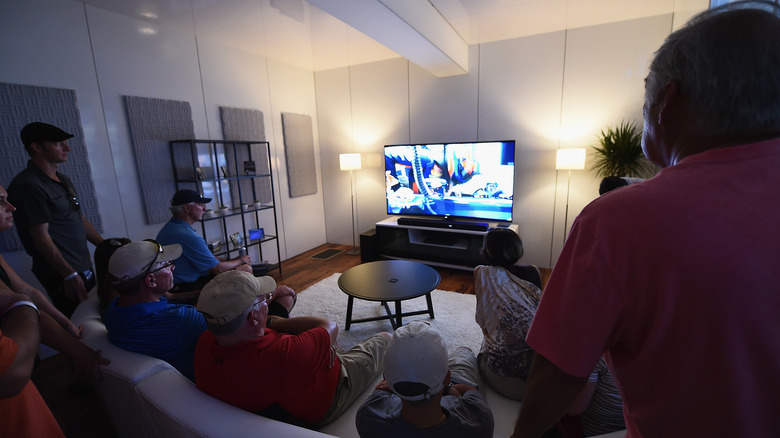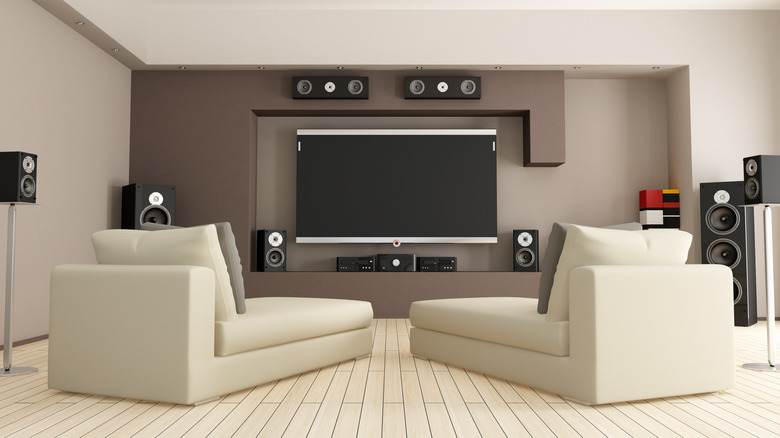What Is True Surround Sound & Can TVs Or Soundbars Produce It?
If you're in the market for a new television or soundbar, you may have noticed that no matter what price range you're shopping in, plenty of models advertise surround sound capabilities of one sort or another. They claim that you'll be able to sit immersed in the center of the action, hearing every car chase like you're in the driver's seat, or soaking in an opera as if from the orchestra pit. But are these just marketing gimmicks, or can a sense of true surround sound be reproduced? And if so, can a soundbar, or even more impressively by built-in TV speakers, do the job?
If you've experienced true surround sound before, you'll know that it truly does feel like magic. For example, watching a movie in a Dolby Cinema theater is a visceral experience during which you'll hear individual bullets moving past your face. Then, you might seem to feel the impact of a nearby explosion. Part of how that's all done is with massive, expensive sound systems that are much larger than what's built into your TV or soundbar. But many promise to get pretty close.
Let's dive into the tech behind surround sound systems to answer how close they really can get, and separate truth from marketing myth. Can you replicate the magic of a surround sound system without investing thousands of dollars into complex speaker arrays?
Object and channel-based audio
To understand what level of sonic immersion your television can produce, it's necessary to know what type of audio experience exist. Surround sound implies feeling like you're at the center of a sound stage, with speakers projecting audio from different angles to effectively make your ears hear the movie's action as if from a specific direction.
Today, there are two ways of achieving this effect: Channel-based audio and object-based audio.
Traditionally, surround sound required extra speakers and a special processing computer to manage them, using technology known as channel-based audio. Each element in an audio track was mixed into individual channels, directed to an individual speaker. So, for a car crash effect to sound like it's coming from behind the listener, a speaker had to physically sit behind them. A TV's built-in speakers can't do that, nor can a standard soundbar without extra satellite speakers.
Today there is also object-based audio, most notably popularized by the Dolby Atmos format, which comes standard on a wide variety of TVs and playback devices (yes, audiophiles, there is a debate between the two top surround sound technologies, DTS:X and Dolby). Object-based audio encoding means that each element in the mix is programmed to be delivered through a certain percentage of each available channel. This also allows for sounds to be programmed so that a wave, for example, sounds as if it's cresting over your head or so that a car zooms past. While the best Dolby Atmos experiences are in theaters optimized for the standard, many TVs can still use a limited version of the Atmos experience right out of the box.
TV speakers and soundbars can produce subtle stereo effects
Back to the question at hand: Can your TV speakers or a basic soundbar create surround sound? The short answer is, "not really."
You'll likely always need a multi-channel speaker setup to get true surround sound. But some consumer televisions can use object-based technology, such as Dolby Atmos, to trick your brain into thinking it's hearing sound from different parts of your room.
The way it's done is the speakers are aimed at different walls, bouncing sound in a way that it creates the illusion of a speaker in that location. But we can only bend the rules of physics so far. Many entry-level Dolby Atmos devices have two speakers that send sound upward. The sound then bounces off the ceiling, creating a dome-shaped bubble of audio around you. This doesn't always work, though, because every room is slightly different. Your TV can't predict what other surfaces those audio waves will bounce from before getting to your ears.
Even in an ideal room setup, don't expect Dolby Atmos to blow your mind unless you're using it with a more expensive multi-channel speaker array. If you want to know what properly tuned Atmos sounds like, find the closest movie theater specially outfitted with as many as 64 speakers needed for an Atmos-mixed movie.
The simple matter is that no soundbar can beat dozens of specialized speakers, professionally tuned for a theater. That doesn't mean home theater-focused versions of Dolby Atmos, DTS:X, or any other method of surround sound, are snake oil. It just means they're not the same.
Surround sound refers to multi-channel audio mixing
For real surround sound that feels truly immersive, you'll need to invest in a multi-channel setup. As you add speakers, you'll need to ensure the sound system can work with them. You'll also need to ensure each speaker is precisely placed in the room, which is one of the biggest headaches of working with Dolby Atmos (or any other technology).
You'll also need to sit in an optimal location relative to each speaker. Your local Dolby Atmos movie theater or other surround sound venue sounds so good because the auditorium is purpose-built, down to the placement of the speakers.
The most common surround sound setups for your home are 5.1 and 7.1 systems. Those initial digits refer to the number of speakers in the setup — five and seven, respectively — while the ".1" refers to a subwoofer. In a 5.1 channel setup, there are three speakers in front of you and two slightly behind your ears, whereas in a 7.1 setup, you'll have an additional two speakers directly even with your ears.
Multi-channel systems from major surround sound brands can get expensive, and may require cutting into your walls to install downward-firing speakers. On the less-expensive side, there are some good options. For example, in our review of the "spatial audio speaker" Sonos Era 300, we found that Sonos's audio features sound great with Dolby Atmos mixes. Alternatively, you can buy a pair of headphones or earbuds that support spatial audio, which often sounds better thanks to head tracking, simulating surround sound. These include the AirPods Max, AirPods Pro, Sony WH-1000XM5, or Samsung Galaxy Buds2 Pro.



